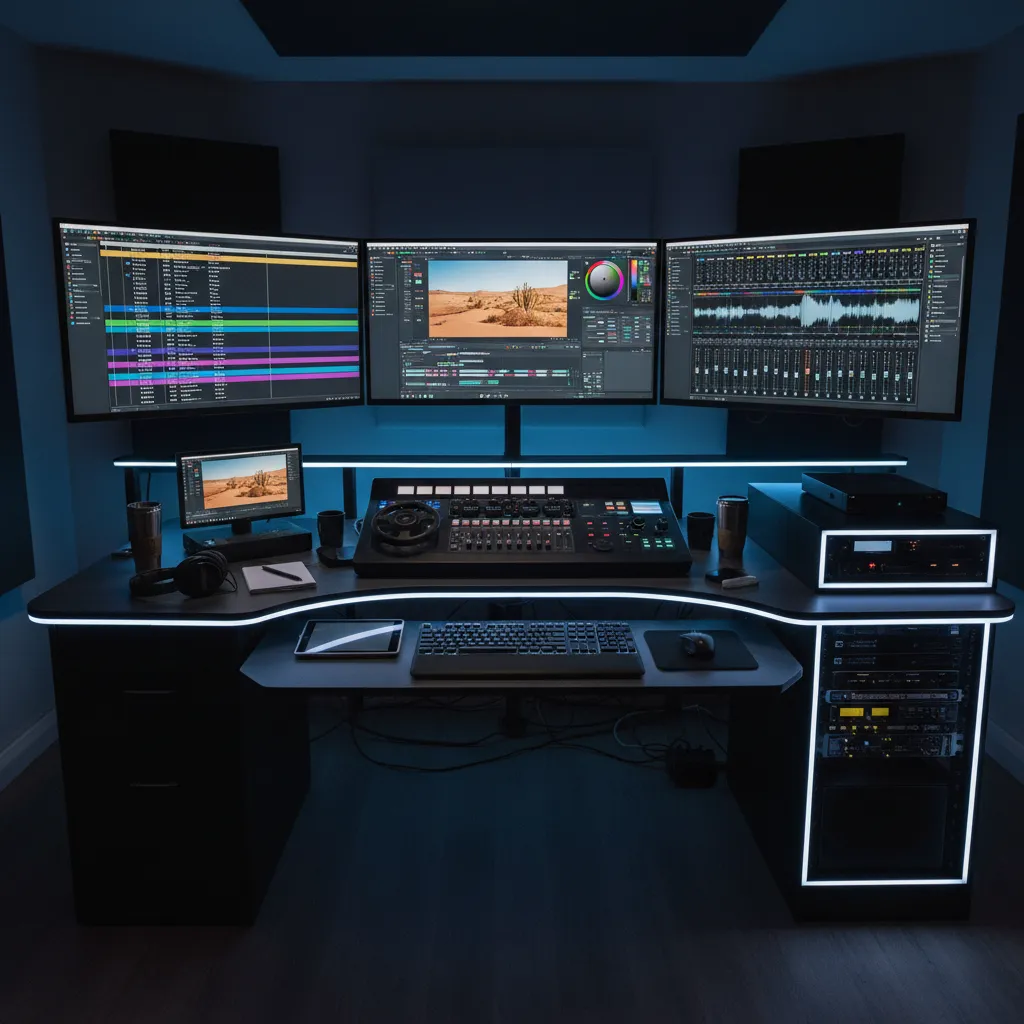
Video Editing Software Comparison: Professional Tools for Content Creators and Businesses
Choosing Video Editing Software That Elevates Creative Potential
Video editing software selection significantly impacts creative workflow efficiency, content quality, and long-term production capabilities, making strategic software choice essential for sustainable content creation success. At M&M Communications, we've utilized diverse editing platforms across hundreds of projects and client requirements, understanding that effective software selection isn't just about technical features—it's about choosing tools that enable creative teams to produce inspirational and magical content efficiently while maintaining professional standards and adapting to evolving business needs and creative challenges.
Understanding Modern Video Editing Landscape
Today's video editing software market offers unprecedented capabilities across price ranges and user skill levels, making informed selection more critical than ever for businesses committed to professional content creation.
The most effective editing software choice balances current production requirements with future growth potential, ensuring initial investment supports immediate needs while providing scalability for increased complexity and enhanced creative ambitions.
Professional software evaluation also considers total cost of ownership including training time, hardware requirements, plugin costs, and collaboration capabilities rather than subscription fees alone, enabling sustainable production workflow development.
Professional-Grade Editing Platforms
Adobe Premiere Pro: Industry Standard Excellence
Adobe Premiere Pro represents the industry standard for professional video editing, offering comprehensive features, extensive third-party integration, and robust collaboration capabilities.
Core Strengths: Professional workflow integration, comprehensive format support, advanced color correction, and seamless Creative Cloud integration that enables sophisticated content creation across diverse project requirements.
Creative Features: Multi-cam editing, advanced audio mixing, motion graphics integration, and extensive effects library that support complex creative projects and professional production standards.
Collaboration Advantages: Team project sharing, version control, and proxy workflow that enable efficient collaboration for distributed teams and client review processes.
Learning Curve: Moderate to steep learning curve that requires investment in training but provides comprehensive capabilities for professional content creation and complex project management.
Final Cut Pro: Mac-Optimized Performance
Final Cut Pro offers exceptional performance optimization for Mac systems with innovative workflow design and professional-grade features tailored for efficient content creation.
Performance Excellence: Optimized Metal framework utilization, efficient proxy workflows, and background rendering that enable smooth editing even with demanding 4K and higher resolution content.
Unique Features: Magnetic timeline, advanced color grading, 360-degree video support, and integrated motion graphics that streamline complex editing tasks and creative workflow.
Cost Effectiveness: One-time purchase model provides long-term value compared to subscription-based alternatives while including regular updates and feature enhancements.
Platform Limitation: Mac-exclusive availability may limit team collaboration in mixed-platform environments or require hardware investment for Windows-based organizations.
DaVinci Resolve: Professional Color and Audio
DaVinci Resolve combines professional editing with industry-leading color grading and audio post-production capabilities in a comprehensive, free package.
Color Grading Excellence: Professional-grade color correction and grading tools that rival dedicated color suites while integrating seamlessly with editing workflow.
Audio Post-Production: Fairlight audio engine provides professional mixing capabilities that eliminate need for separate audio software in many production scenarios.
Collaboration Features: Built-in project sharing and real-time collaboration that enable distributed team workflows and client feedback integration.
Free Tier Value: Comprehensive features available without cost provide exceptional value for budget-conscious operations while paid version adds advanced features.
Intermediate and Accessible Platforms
Adobe Premiere Elements: Consumer-Friendly Power
Adobe Premiere Elements provides simplified video editing with automated features and guided tutorials that enable quality content creation without professional training requirements.
Automated Features: AI-powered editing suggestions, automatic color correction, and guided tutorials that accelerate learning while ensuring professional-looking results.
Template Library: Extensive preset collection including transitions, titles, and effects that enable rapid content creation while maintaining visual consistency.
Hardware Requirements: Lower system requirements enable editing on standard business computers without specialized hardware investment or technical infrastructure.
Output Options: Comprehensive export presets for social media, web, and standard video formats that simplify content distribution across multiple platforms.
Filmora: User-Friendly Creativity
Filmora balances ease of use with creative features, enabling rapid content creation while providing professional-quality output for diverse content requirements.
Intuitive Interface: Drag-and-drop functionality and logical workflow design that minimize learning time while enabling efficient content production.
Creative Assets: Built-in music library, effect collections, and title templates that reduce need for external asset sourcing while maintaining creative flexibility.
Performance Optimization: Efficient rendering and preview systems that enable smooth editing on moderate hardware specifications without performance compromisation.
Regular Updates: Frequent feature additions and template updates that expand capabilities while maintaining subscription value and competitive feature sets.
Specialized and Emerging Platforms
Avid Media Composer: Broadcast Professional Standard
Avid Media Composer serves broadcast and film industry requirements with advanced project management and collaboration features for complex, multi-editor productions.
Project Management: Sophisticated bin organization, advanced trimming tools, and comprehensive media management that support large-scale production requirements.
Industry Integration: Standard in broadcast and film post-production with extensive hardware integration and professional workflow support.
Collaboration Excellence: Advanced sharing and project management capabilities that enable efficient large-team collaboration and client integration.
Complexity Consideration: Steep learning curve and high cost may not justify investment for smaller-scale content creation or business video requirements.
Cloud-Based Editing Solutions
Emerging cloud platforms like WeVideo and Clipchamp provide browser-based editing that eliminates software installation while enabling collaboration and accessibility.
Accessibility Advantages: No software installation requirements and device-independent access that enable editing from diverse locations and hardware configurations.
Collaboration Features: Real-time sharing and commenting that streamline client feedback and team collaboration without file transfer complications.
Storage Integration: Cloud storage and automatic backup that protect content while enabling access from multiple devices and locations.
Performance Limitations: Internet dependency and potential processing limitations compared to desktop applications may affect complex project efficiency.
This evaluation approach reflects M&M Communications' philosophy: we don't recommend expensive software to demonstrate technical sophistication or justify higher service fees. Instead, we help businesses choose inspirational and magical tools that enable their creative teams to produce outstanding content efficiently while building sustainable production capabilities and creative confidence.
Hardware Requirements and Performance Optimization
System Specifications and Planning
Different editing platforms require varying hardware specifications that affect performance, rendering speed, and overall editing efficiency across different content types and project complexity levels.
CPU and GPU Requirements: Modern editing benefits from multi-core processors and dedicated graphics cards that accelerate rendering and enable real-time effects preview during creative workflow.
Memory and Storage Considerations: Adequate RAM (16GB minimum, 32GB+ preferred) and fast storage systems (SSD recommended) that prevent bottlenecks during complex project editing and media management.
Display and Interface Optimization: Multiple monitor support and color-accurate displays that improve editing efficiency while ensuring accurate color representation for professional content creation.
Workflow Optimization Strategies
Optimize editing performance through proxy workflows, cache management, and hardware acceleration that enable smooth editing regardless of source material quality and complexity.
Implement storage strategies including media organization, backup systems, and archive workflows that protect content while maintaining efficient access to active projects and assets.
Plan hardware upgrade pathways that enable capability growth without complete system replacement as project requirements and content complexity evolve over time.
Collaboration and Workflow Integration
Team Collaboration Features
Evaluate collaboration capabilities including project sharing, version control, and comment systems that enable efficient team workflow and client feedback integration.
Consider cloud integration and remote access capabilities that support distributed teams and flexible work arrangements while maintaining security and project integrity.
Plan approval workflows and client review systems that streamline feedback collection while maintaining project timeline efficiency and creative control.
Integration with Production Pipeline
Ensure editing software integrates effectively with camera systems, audio equipment, and graphics software used in production workflow for seamless content creation.
Evaluate compatibility with stock media libraries, music licensing platforms, and asset management systems that streamline content creation while maintaining legal compliance.
Consider integration with distribution platforms and content management systems that enable efficient publication and content syndication across multiple channels.
Cost Analysis and Investment Planning
Total Cost of Ownership Assessment
Calculate comprehensive costs including software licensing, training time, hardware upgrades, and plugin purchases that affect long-term editing platform investment value.
Subscription vs. Purchase Models: Evaluate ongoing subscription costs versus one-time purchases based on usage patterns, feature requirements, and budget predictability preferences.
Training and Skill Development: Factor training time and skill development requirements that affect productivity during transition periods and long-term team capability building.
Hardware and Infrastructure: Consider hardware requirements and potential upgrade costs that may be necessary for optimal software performance and professional content creation.
Scalability and Growth Planning
Choose editing platforms that can accommodate business growth and increasing content complexity without requiring complete software transition or workflow disruption.
Evaluate upgrade pathways and advanced feature availability that enable capability enhancement as content requirements and creative ambitions develop over time.
Consider multi-user licensing and team expansion capabilities that support business growth while maintaining cost control and operational efficiency.
Training and Skill Development
Learning Resources and Support
Evaluate available training resources including official tutorials, community forums, and professional training programs that accelerate skill development and problem resolution.
Consider certification programs and professional development opportunities that enhance team capabilities while building credible expertise and industry recognition.
Plan ongoing education and skill updates that keep pace with software evolution and industry standard changes while maintaining competitive creative capabilities.
Team Skill Assessment
Assess current team capabilities and learning preferences that affect software selection and training investment requirements for optimal productivity and creative output.
Identify skill gaps and development priorities that inform software choice while planning capability building that supports business objectives and creative goals.
Security and Content Protection
Project Security and Backup
Implement comprehensive backup systems and version control that protect valuable content while enabling recovery from technical failures or accidental changes.
Consider cloud storage security, local backup redundancy, and access control systems that protect intellectual property while enabling necessary collaboration and sharing.
Client Confidentiality
Ensure editing workflows protect client confidentiality and intellectual property through secure storage, controlled access, and appropriate data handling procedures.
Future Technology Trends
AI and Automation Integration
Monitor artificial intelligence features including automated editing, content analysis, and workflow optimization that may enhance productivity and creative capabilities.
Cloud Workflow Evolution
Track cloud-based editing development and remote collaboration enhancement that may affect future workflow design and team collaboration strategies.
Selection Framework and Decision Making
Evaluation Criteria and Testing
Develop systematic evaluation criteria that assess software capabilities against specific business requirements, creative needs, and operational constraints.
Implement trial periods and testing protocols that enable informed decision making while minimizing disruption to ongoing production activities and client commitments.
Implementation Planning
Plan software transition strategies that minimize disruption while ensuring team training and workflow adaptation that maintains productivity during change management.
Conclusion: Strategic Software Selection for Creative Excellence
Video editing software selection requires comprehensive evaluation of capabilities, costs, and integration requirements that align with business objectives while supporting creative excellence and efficient workflow development.
At M&M Communications, we understand that exceptional editing software isn't necessarily the most feature-rich or expensive option—it's the platform that enables creative teams to produce inspirational and magical content efficiently while supporting business growth and creative evolution through strategic capability building.
The future belongs to businesses that can balance creative ambition with practical workflow requirements, choosing editing tools that enhance rather than complicate content creation processes. Select editing software strategically, invest in proper training and infrastructure, and discover how the right tools can transform your content creation capabilities and creative potential.

